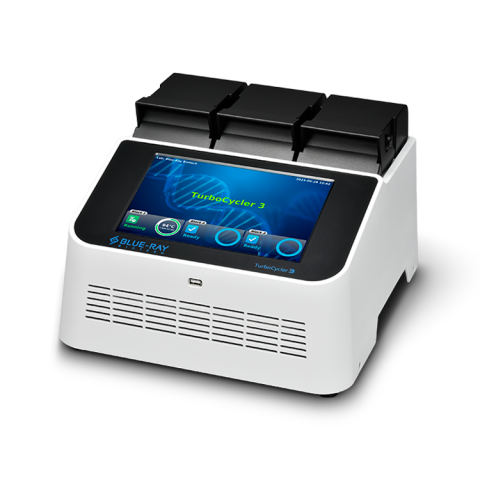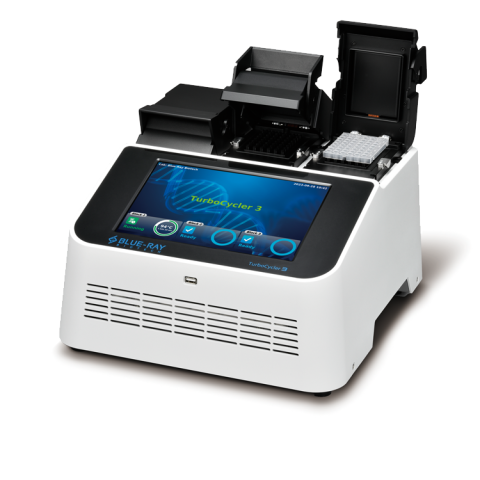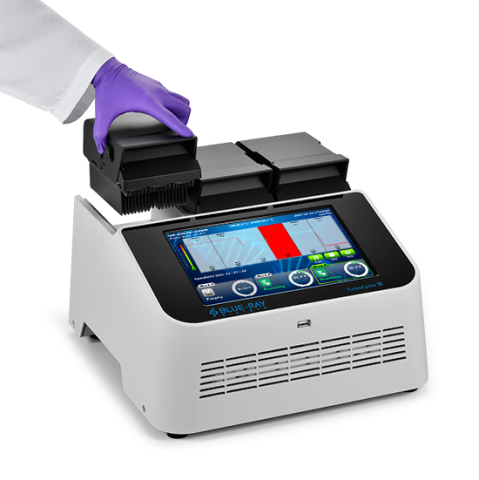Gradient Cycler Turbo3

High-Throughput Triple-Block Gradient PCR Thermal Cycler
TurboCycler 3 stands out as the ultimate high-throughput PCR thermal cycler in its class. It has unrivaled flexibility and the capacity to run three distinct PCR protocols at the same time while handling 3 x 48 samples.
Its independent 3-block design allows your lab to easily perform experiments with multiple thermal conditions and high throughput. The TurboCycler 3 is a multi-block PCR thermal cycler with three independently controllable blocks, each with gradient temperature capability—specifically designed for labs requiring a multitasking solution.
Fast gradient optimization and advanced ramp rate control are perfectly tailored to meet specific assay requirements. These features unite to turbocharge your productivity and efficiency.
Request a quoteGradient Cycler Turbo3
Specifikations
- Triple-Block Flexibility
Three distinct PCR protocols can be run at the same time, perfect for multi-user environments and diverse experiments with low samples. - Fast Gradient Optimization
PCR conditions across the three independent blocks are easily adjusted and range from 30 to 100°C with a maximum span of 30°C. - Advanced Ramp Rate Control
Ramp rate can be adjusted from 0.1 to 5.0°C/sec, to accommodate different assays including CRISPR-related experiments. - High-Throughput Efficiency
Maximize throughput with up to 3 x 48 x 0.1/0.2 ml samples. - Intuitive Operation
Effortless programming on a large 10.1” color touch screen with a user-friendly interface. - Continuous Reliability: Zero Downtime
Each of the three independent block modules can be independently calibrated to ensure uninterrupted operation during maintenance.
Options
- Tube frame for use to maintain the equilibrium pressure, if the PCR plate is deformed.
- Compression mat
The 5 mm compression mat must be used to ensure sufficient contact pressure of the heated lid.
| Sample Block | |
| 3 x 48 well, Gradient Block | Compatible with 0.2 ml or 0.1 ml PCR tubes, strip-tubes, non-skirted and semi-skirted 48-well plate |
| Independent Block Operation | Supported |
| Independent Block Maintenance | Yes (removable blocks) |
| Block Temperature | |
| Temperature range | 4.0 – 100 °C |
| Max. heating rate | 5.0 °C/s |
| Max. cooling rate | 3.0 °C/s |
| Temperature accuracy | ± 0.3 °C |
| Temperature uniformity | ± 0.4 °C |
| Adjustable ramp rate | 0.1 – 5.0 °C/sec |
| Gradient | |
| Gradient direction | vertical accross the block |
| Gradient temperature | 8 zones per block |
| Temperature range | 30 – 100 °C |
| Temperature difference | max. 30 °C |
| Heater Lid | |
| Temperature setting range | 35 – 120 °C or off |
| Temperature accuracy | ± 1.0 °C |
| Software | |
| Portability of protocols | Save and transfer to computer or TurboCycler3 via USB flash drive |
| Stored program number | > 4000 |
| Registered user folder number | 100 |
| User folder password protection | Yes |
| Run status report | Yes, HTML output and transfer via USB flash drive |
| Real-Time temp. profile export | Yes, CSV output and transfer via USB flash drive |
| Tools | Tm calculator, Copy number convertor, Master mix preparation wizard |
| General Technical Data | |
| Order Number Turbo3 | 112.6015 |
| Touchscreen | 10.1" color LCD |
| Data port | 1 USB Type A front port for USB flash drive |
| Auto restart after power outage | Yes |
| Dimensions (H x W x D) | 236 x 356 x 362 mm |
| Weight | 13 kg |
| Power supply | AC 100-240 V, 50/60 Hz, 1000 W |
| Certification | CE |
What is the temperature range of the lid of TurboCycler3?
There are four different temperature settings for the lid:
1. 130°C (for use with low-profile vessels + compression mat), with an extra 3 minutes of pre-heat.
2. 105°C
3. Heater off
4. Any temperature between 35°C - 130°C
Is the ramping rate of Turbo3 adjustable?
Yes! The ramping rate of Turbo3 can be adjusted from 0,1°C to 5.0°C
Will the heating blocks influence each other´s performance during PCR experiments?
Each heating block has its individual heating element, heat sink, electirc fan, ventilation channel..., so they will not interact with each other.
What are the block and sample modes for Turbo3?
- Block mode: Enables system operation with maximum temperature control based on the actual block temperature regardless of the sample temperature. This mode is designed to mimic the control algorithm used in most early model thermal cyclers.
- Sample mode: Enables system operation with simulated tempertature control. Users are required to input the sample volume: 5-100µl. In this mode, the temperature control algorithm will estimate the sample temperature based on the block temperature and sample volume. This is the mode recommended for normal operation.
Can Turbo3 run overnight?
Yes! But we do not recommend this be done very often. Running your cycler overnight at 4°C can potentially reduce the life cycle of the instrument. In most applications, 16°C instead of 4°C for overnight storage can protect your DNA sample very well.
How many sets of protocols and history can be stored in Turbo3? What will happen if my data exceeds the limit?
The storage limits are:
- Protocol: >4000 sets
- History: 50 sets
- User folder: 100 sets
When the storage of protocols has reached the limit, a message will remind the user to delete some protocols. The system will not overwrite existing protocols.
However, when history storage reaches its limit, new histories will over-write the oldest. However, the user can set a reminder thas shows when history storage gets close to the limit.
Which accessory should I apply to each different volume of tube?
The low-profile PCR vessel design reduces the overhead space above the reaction solution inside the vessel.
During thermal cycling, water in the solutions evaporates and fills the overhead space. This causes a concentration increase in the reacting solution.
The smaller the overhead space, the smaller the amount of evaporated water and concentration change in the solution. This is especially helpful when low volume reaction mixtures are being used.
In general, the low-profile PCR vessels are 5 mm shorter in height than the regular PCR vessels.
For standard PCR vessels, use the frame and set the lid heat to 105°C to balance the pressure from the lid heater. For low-profile PCR vessels, use the compressor mat and set the lid heat to 130°C to maintain the pressure in the vessels.
What is the function of the lid? What is the effect of evaporation? Does the lid temperature cycle during experiments? Do the competivive units do the same? What is the temperature of the lid at the 4°C step?
Lid heating prevents severe condensation in the PCR tubes during the reaction.
The amount of evaporation is related to t he sealing of the PCR vessels. A firm pressure on the lid will help maintain the integrity of the seal and prevent evaporation.
The lid temperature does not cycle and the competitive units do not cycle either.
When the heating block temperature drops below 30°C, the lid heater is turned off and the temperature of the lid decreases gradually. Competitive units do this aswell.



